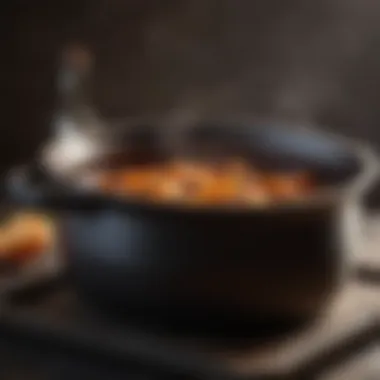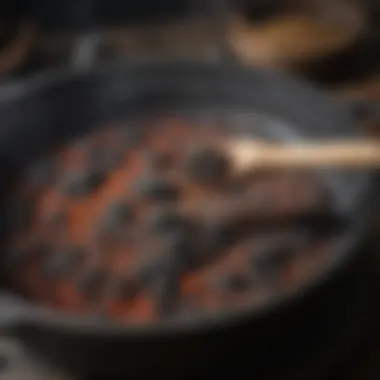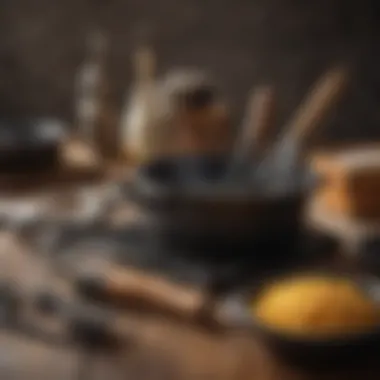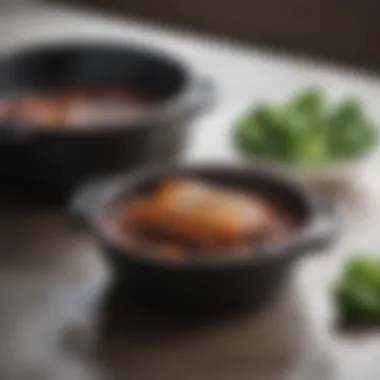Essential Techniques for Cleaning Cast Iron Pots


Intro
Cleaning cast iron pots is not just about keeping them shiny and neat; it’s about preserving a culinary tradition that has endured through generations. These pots are more than mere cookware; they’re vessels that hold the potential for creating unforgettable meals. However, the care they require might seem daunting at first, especially if you’ve inherited one from Grandma or picked one up at a flea market. But fret not! This guide lays down practical steps and insights to ensure your beloved cast iron remains in peak condition, enhancing not just its performance but also the flavors of your dishes.
Many folks may have a hodgepodge of advice when it comes to cleaning these pots. Some swear by scrubbing with coarse salt, while others are zealous about using soap. The aim here is to demystify these conflicting techniques and establish a solid foundation of what works best so you don't have to navigate through a sea of doubt. By understanding the unique properties of cast iron and how to care for it properly, you’ll not only prolong the life of your cookware but also enhance your culinary experience.
Let’s delve deeper into the nitty-gritty of keeping your cast iron pot in tip-top shape, focusing on essential techniques that ensure safe cooking and longevity. From the initial scrub down to the long-term maintenance, we’ll cover it all.
Understanding Cast Iron Cookware
When it comes to cooking, cast iron pots are celebrated for their durability and excellent heat retention, making them a staple in many kitchens. Understanding the essence of cast iron cookware allows enthusiasts and novices alike to appreciate the unique qualities that these pots bring to the table. They are not merely cooking vessels; they are an investment in culinary tradition, capable of delivering mouthwatering dishes while boasting longevity that surpasses most modern alternatives.
The Composition of Cast Iron
Cast iron is comprised of iron, carbon, and silicon. The mixture is poured into molds to create the desired shape. This unique composition gives cast iron its strength and ability to retain heat; it heats evenly across its surface when placed on a stovetop or in an oven. Unlike non-stick cookware, cast iron develops a natural non-stick surface over time, known as seasoning. While other materials may warp or degrade, cast iron endures, becoming an heirloom that can be passed down through generations.
In a well-cared-for cast iron pot, the seasoning transforms over years of use, creating a non-stick barrier that enhances flavors with each meal cooked in it. Understanding that the art of cooking with cast iron is tied deeply to its makeup is essential for anyone looking to maximize its potential in the kitchen.
The Benefits of Cast Iron Cooking
There are numerous advantages linked with using cast iron pots. For instance:
- Heat Retention: They retain heat extraordinarily well, adding a nice sear to meats, which helps lock in flavors.
- Versatility: These pots can go seamlessly from stovetop to oven, making them perfect for a variety of cooking methods, whether braising, frying, or baking.
- Nutritional Boost: Cooking with cast iron can also contribute small amounts of iron to your food, beneficial for overall health.
- Cost-Effectiveness: A well-maintained cast iron pot can last a lifetime. The initial price may seem steep, but the longevity and performance over time make them a smart buy.
Having these insights can make one regard cast iron not just as cookware, but as an essential gear for producing culinary masterpieces.
The Importance of Proper Cleaning
Proper cleaning of cast iron cookware is not only important for maintaining its appearance but also crucial for preserving its functionality. Cast iron is porous, meaning it can absorb flavors and odors over time. If not cleaned correctly, this can lead to unpleasant tastes in future dishes.
Moreover, neglecting the right cleaning practices can cause rust, ultimately ruining a perfectly good pot.
- Avoid Harsh Detergents: Unlike other cookware, soap can break down the seasoning layer; a simple scour with hot water and a brush is often adequate.
- Immediate Attention: Cleaning soon after use helps prevent food from sticking and makes the process considerably easier.
"A well-cared-for cast iron pot is a reliable friend in the kitchen."
Developing a routine for cleaning, drying, and seasoning will ensure that your cast iron pot remains in prime condition for years to come. Understanding these aspects of cast iron cookware lays a foundation for benefiting from this remarkable cooking method and enjoying its numerous surprises in the kitchen.
Immediate Cleaning Post-Cooking
Cleaning your cast iron cookware right after you've finished cooking isn't just a matter of preference; it's a crucial practice for maintaining the integrity and longevity of your pots. The thing is, cast iron is quite absorbent, and if you let food residue sit, it can lead to rust or hard-to-remove stains. Besides, cleaning the pot promptly keeps your cooking environment tidy and sets you up for a more welcoming experience during the next meal prep.
What to Do Immediately After Use
Immediately after using your cast iron pot, you should follow a few straightforward steps to ensure it's cleaned properly without compromising its condition. Here’s what you need to do:
- Let it Cool: Don’t plunge your hot cast iron directly into cold water. That sudden temperature change could warp the metal. Allow it to cool naturally for about 10-15 minutes.
- Scrape Off Food Residue: Use a wooden or silicone spatula to scrape off any stuck bits of food. If you're working with something really clingy, a gentle pat with a scraper can work wonders.
- Rinse with Warm Water: Under running water, rinse the pot. It's best to use warm water. Cold water might not dislodge everything effectively. Be mindful not to use cold water after it's just come off the heat, though; that's just asking for trouble.
- Use a Brush or Cloth: If you need more assistance getting that residue off, a stiff-bristled brush or a cloth will do the trick. Avoid metal brushes; you shouldn't scratch the surface of your pot.
- Dry Thoroughly: After rinsing, make sure to dry the pot completely with a towel. Or, return it to low heat for a few minutes. This will drive out any moisture, minimizing the risk of rust. If you leave any water behind, you could be looking at trouble down the line.
Avoiding Common Mistakes
While it might seem simple, there are mistakes that often pop up during the cleaning process. Understanding these can save you from future headaches:
- Don’t Soak the Pot: It might be tempting to soak your cast iron, but that should be a no-go. Extended exposure to water can lead to rust, severely impacting its cooking capabilities.
- Avoid Soap: While many people think soap is a good cleaner, it can strip away the pot's well-developed seasoning. If you do need a deep cleaning (like after cooking something particularly smelly), use something like baking soda instead, as it’s less aggressive.
- Skip the Dishwashers: Just like you wouldn't stick your precious leather shoes in the washing machine, don't toss your cast iron pot into the dishwasher. It's not just ineffective; it can ruin the seasoning.
Remember, maintaining your cast iron pot is not just about cleaning. It's about preserving its heritage and ensuring your food tastes its best!


By avoiding these simple pitfalls and proactively cleaning after each use, you'll ensure your cast iron pot serves you well for years to come.
Essential Cleaning Techniques
Cleaning cast iron cookware is not just about making it look presentable—it's about preserving your investment and safeguarding your culinary adventures. Proper cleaning techniques play a pivotal role in maintaining the integrity of the cast iron surface, which in turn enhances cooking performance and extends the life of your pots. Ignoring the finer points of cleaning can lead to rust, stubborn stains, and a compromised cooking surface that just won’t heat evenly, ultimately spoiling your meals.
Key aspects of effective cleaning methods include using the right materials and understanding the structure of cast iron itself. By approaching the task with care, you'll keep your pots in prime condition, allowing flavors to meld and develop with every meal.
Using Water and a Scrub Brush
One of the simplest yet most effective methods for cleaning cast iron is the basic combination of water and a scrub brush. This technique is particularly beneficial immediately after cooking. When the pot is still warm, but not scalding, rinse it with hot water.
Here’s how you can go about it:
- Rinse your pot: Start by rinsing the pot under warm water to loosen any residual food particles.
- Grab a suitable brush: Use a stiff-bristled scrub brush, as it is ideal for dislodging food without damaging the seasoning layer.
- Scrub gently: Avoid aggressive scrubbing. The goal is to remove stuck bits efficiently while preserving the seasoning.
- Rinse thoroughly: After scrubbing, a light rinse will remove anything that’s been dislodged.
Using just water keeps the pans dry and helps prevent rusting, allowing the cast iron’s natural properties to shine through.
Baking Soda and Salt Method
If you find your pot bearing the weight of burnt bits from past meals, turning to the baking soda and salt method can work wonders. This duo isn’t just for baking—they can work together to tackle those tenacious stains with grace.
- Sprinkle generously: Start by sprinkling a mixture of baking soda and coarse salt onto the bottom of the pot.
- Add water to make a paste: Drizzling a few tablespoons of water creates a paste that sticks around even when you start scrubbing.
- Scrub with a bit of elbow grease: Use your scrub brush to work the mixture into the stained areas, all the while being careful to not dig too deep into the surface.
- Rinse and dry: Finish off by rinsing well and drying promptly to ward off rust.
This method not only clears the grime, but it also refreshes your pot’s seasoning, making it ready for the next culinary adventure.
Utilizing Vinegar for Stubborn Stains
When it comes to cast iron, not all stains are created equal. If you encounter those truly stubborn patches that resist other cleaning techniques, vinegar can come to the rescue. Its acidity works to break down carbonized residues without harming the iron.
- Create a vinegar solution: Mix equal parts water and white vinegar in a basin.
- Soak the pot: Let the pot soak in this solution for about 30 minutes, never longer to avoid stripping the seasoning completely.
- Scrub with care: After the soak, use a brush to wipe away the lifted debris.
- Rinse well: Ensure that all vinegar traces are rinsed away before drying.
Remember: Acidic solutions should be used sparingly as excessive use can erode the seasoning, so they’re best saved for truly obstinate stains.
The Role of Oil in Cleaning
Interestingly, oil also plays a significant part in cleaning and maintaining cast iron pots. After scrubbing, applying a light coat of oil can revitalise the seasoning and form a protective layer against moisture.
- Choose a high smoke point oil: Good options include grapeseed, flaxseed, or canola oil.
- After drying: Once your pot is clean and thoroughly dried, take a small amount of oil on a paper towel.
- Rub it in: Spread it all over the cooking surface and even on the outside if desired. This not only protects the iron but can also help with the performance during future cooking sessions.
Regularly oiling helps build a resilient layer against moisture and contributes to the pot's extraordinary non-stick properties over time.
Following these handling techniques will keep your cast iron in tip-top shape, ready to create delightful meals with your newfound cleaning expertise.
Dealing with Rust
Dealing with rust on cast iron pots is crucial for maintaining their quality and functionality. Cast iron, while incredibly durable and long-lasting, is not impervious to the elements. Moisture can seep into those charming pores of the cookware, leading to rust, which compromises the surface and the food safety of the pot. Recognizing and addressing rust promptly not only extends the lifespan of your cookware but also keeps your meals tasting their best. When neglected, rust can turn a beloved family heirloom into a kitchen disaster.
Identifying Rust on Cast Iron
So, how can you identify rust on your cast iron? Firstly, look for the telltale signs: a reddish-brown discoloration or flaking of the surface often signifies rust. You might notice that your once-smooth seasoning feels rough or grainy to the touch—this is usually a warning bell.
- Inspect the Pot Regularly: Make a habit of checking your cast iron pot during cleaning. A close look can save you a lot of trouble in the long run.
- Use Light Scratches as Indicators: If you run a fingernail over the surface and it snags, it’s a hint that the patina is breaking down, allowing oxidization to creep in.
- Evaluate the Rust Color: Fresh rust might appear bright orange, while older rust could take on a deeper, more muted shade.
Techniques for Rust Removal


When it comes to taking action against rust, you have several techniques at your disposal. Here’s how to tackle it:
- Scrubbing with Steel Wool: The first step often involves a good scrub. Using fine steel wool can be effective. Just be gentle so you don’t gouge the iron. This method works well for surface rust and starts the restoration process.
- Using Vinegar: A vinegar soak can do wonders. Mix equal parts water and vinegar, submerge the rusted piece, and let it sit for a few hours. The acetic acid helps to dissolve the rust. Just remember, this is for lighter rust; heavy rust may need more aggressive removal.
- Baking Soda Paste: Another method is creating a paste from baking soda and water. Apply it on the rusted areas, let it sit a while, and then scrub away. This offers a gentle abrasive that can lift rust without damaging the iron underneath.
- Oven Cleaner: As a last resort, some people use an oven cleaner spray for stubborn rust. It’s potent and should be handled with care, but can be quite effective in removing heavy build-up.
- Re-Seasoning: Once you’ve tackled the rust, don’t forget to re-season your cast iron pot. This step restores the protective coating and helps prevent future rusting.
"A well-maintained cast iron pot is like an old friend; it only gets better with age if cared for properly."
Keeping an eye on rust and knowing how to deal with it is instrumental in preserving your cast iron cookware for generations. Each method has its place depending on the severity of the rust, but being proactive about rust maintenance is always the key to keeping your pots ready for the next culinary adventure.
Drying and Seasoning the Pot
Drying and seasoning your cast iron pot is not just a nitpicky chore; it’s the backbone of preserving its integrity and functionality. After washing and cleaning, moisture can be a cooking companion you definitely don’t want. If left unchecked, it can lead to rust, disaster, and heartache. So, let’s take a closer look at the importance of thorough drying followed by the steps needed to season your treasured cookware.
Importance of Thorough Drying
Thorough drying is crucial for multiple reasons. First off, moisture is a cast iron pot's worst enemy. When you finish cleaning your pot, any leftover water can result in rust forming on the surface. Cast iron is porous, meaning it sucks up moisture like a sponge. If you think you can just dry it with a towel, think again! The water can remain trapped in those tiny pores, leading to eventual oxidation.
- Preservation: Drying it well not only protects against rust but also maintains the quality of any seasoning that might have been applied previously.
- Functional Surface: A dry pot provides a solid and even cooking surface. Leftover moisture can compromise its heat distribution when cooking.
- Aesthetic Appeal: Nobody wants to look at a pot that looks like it has been through a rainstorm. Keeping it dry ensures it looks as good as it cooks.
Take a moment and think about it; even when the pot’s still warm, it's best to give it a little more love and ensure all the moisture is wiped away. You'll have a pot that serves you well for years without the nagging worry of rust.
Steps to Season Your Cast Iron
Now that your pot is dry, it’s time to dive into the seasoning process. Seasoning creates a non-stick, protective layer that enhances cooking, prevents rust, and imparts flavor to your dishes. Here’s how to do it:
- Choose the Right Oil: For a well-formed seasoning layer, choose an oil with a high smoke point like flaxseed oil, grapeseed oil, or canola oil. Avoid oils that can spoil easily.
- Preheat Your Oven: Set your oven to about 375°F (190°C). This preheating will help to open up the pores of the cast iron.
- Apply the Oil: Use a paper towel or cloth to apply a thin layer of oil all over the surface of the pot, including the handle and the bottom. Less is more here; you just want to coat the surface lightly.
- Bake the Pot: Place the pot upside down on the middle rack of your oven. It’s crucial to put a sheet of aluminum foil or a baking pan on the lower rack to catch any drips.
- Time it Right: Let it bake for about an hour. This heat will polymerize the oil, creating that hard, non-stick surface we all crave.
- Cool Down: After an hour, turn off the oven and let the pot cool down before removing it. This cooling process allows the seasoning to set properly.
When done right, the result will be a pot ready for many delightful meals, standing the test of time with grace.
"A well-seasoned cast iron pot isn’t just a cooking vessel; it’s a culinary companion that ages like fine wine."
Storage Tips for Cast Iron Cookware
Proper storage of cast iron pots is crucial to maintaining their quality and extending their lifespan. Storing these works of art correctly ensures that they are ready for action whenever you feel like whipping up a feast. The residual oil acting as a barrier against moisture and air is an essential aspect that helps keep your cast iron in prime condition. When you know how to treat your cast iron right, you can save yourself a lot of hassles down the road.
Optimal Conditions for Storing
Finding the right spot for your cast iron cookware goes beyond just sticking it in a cupboard. Ideally, you want to give these pots a cozy nest to rest in. First off, make sure they're completely dry before storage. Any lingering moisture can lead to rust, which is the last thing you need. Consider placing a cotton cloth or paper towel inside the pot to further absorb any leftover moisture, especially in humid climates.
There’s also a fine line when it comes to stacking your cast iron. If you’re inclined to stack your pots to save space, simply add a soft cloth or paper towel between each one. This method won’t just prevent scratches but will also protect the seasoning on the surface.
Another key factor in optimal storage is the temperature. It’s best to keep your cookware in a cool, dry place, away from direct sunlight. Sun exposure can cause the oil on your pots to break down, diminishing their non-stick abilities.
Preventing Moisture Buildup
Humidity is the enemy of cast iron cookware. If you're in a region where humidity levels can get high, it’s wise to take some proactive steps to combat moisture buildup in your pots. Consider using silica gel packets that are commonly found in shoe boxes or purchasing specialized moisture absorbers to include in your storage area.
Regularly inspecting your cast iron can also help catch any signs of moisture issues early. If you find a stubborn spot of rust forming, it’s often easier to resolve it when it’s small rather than letting it fester. Investing time into preventing moisture today saves you from costly restorations later on.
"The best armor against moisture buildup is a little bit of diligence and a lot of love for your cast iron. Treat them well, and they'll treat you right by serving up the best meals."
Overall, the storage of your cast iron pots requires consideration and care. By following these tips, you’ll create a safe haven for your cookware, preserving their integrity for years to come.
Addressing Frequent Concerns
Cleaning and maintaining cast iron pots can bring up a slew of questions that many owners may feel hesitant to ask. These concerns are valid, as improper care can not only damage the cookware but also alter its performance in the kitchen. Addressing frequent concerns is crucial for not just maintaining the cast iron's look but ensuring its longevity and functionality. A well-cared-for pot becomes an heirloom piece, passed down through generations, embodying both heritage and history.
Understanding the most common queries related to cast iron care can empower owners to make educated decisions, thereby enhancing their cooking experiences.


Can You Soak Cast Iron?
This question comes up quite a bit in discussions around cast iron care. The straightforward answer is: not really. Soaking a cast iron pot in water can cause it to rust. It can also disrupt the seasoning that acts like a protective barrier on the surface. When cooking residues adhere to the pot, your first instinct may be to think that a soak will make it easier to clean. However, this practice can often have the opposite effect.
Consider these points:
- Rust Risk: Leaving cast iron submerged can lead to rust spots due to prolonged exposure to moisture.
- Seasoning Damage: The natural oils in the cast iron that create a non-stick surface can be stripped away.
- Food Safety: Any bacteria present might become problematic if not immediately addressed.
Instead of soaking, it’s better to use hot water and a scrub brush soon after cooking to remove food particles effectively. Letting the pot sit without cleaning is a much better approach than immersing it completely in water.
Should You Use Soap?
The age-old debate continues: is it permissible to use soap on cast iron cookware? A nuanced answer is needed here. Traditional wisdom says to avoid soap, as it might strip the seasoning; however, this isn’t necessarily a hard and fast rule.
Best practices regarding soap use include:
- Mild Soaps: If you feel compelled to use soap, opt for a mild one. A tiny amount won’t hurt, especially if your pot has significant buildup.
- Light Scrubbing: Combine the soap with hot water and a scrub brush, but ensure it is minimal.
- Immediate Rinsing: Always rinse thoroughly to ensure no soap residues linger.
In general, use soap sparingly and never let it become a crutch for deep cleaning. Frequent and proper maintenance will warrant less need for soap in the first place.
How to Remove Food Odors
Food odors lingering in your cast iron pot can be bothersome. It’s particularly common if you’ve cooked strongly flavored dishes like curry or garlic-heavy meals. Fortunately, there are effective ways to neutralize these odors without compromising your pot’s integrity.
To combat unwanted smells, consider the following techniques:
- Vinegar Solution: Mix equal parts of vinegar and water and bring it to a light simmer in the pot. The acid in the vinegar works wonders to cut through offensive smells.
- Baking Soda Paste: Form a paste using baking soda and a touch of water. Scrub it into the pot, let it sit for 15-20 minutes, and wash it off.
- Airtight Storage: Always avoid storing food in your cast iron. Instead, let it air dry completely before storage to reduce any chance of odor absorption.
Ultimately, frequent and mindful care can be a gamechanger, ensuring your cast iron remains odor-free and ready for your next culinary venture. Taking the time to address these concerns can maintain the joy of cooking with these beloved pots.
When to Seek Professional Help
When it comes to taking care of cast iron cookware, most enthusiasts like to think they can handle the routine maintenance on their own. However, there comes a time when you might need to reach out to a professional. Understanding when to seek expert help can be crucial to preserving the functionality and aesthetic appeal of your beloved pots. Not every problem can be sorted with a little elbow grease or DIY methods. Let’s dive into the specific elements that could signal the need for professional restoration.
Signs Your Pot Needs Professional Restoration
- Severe Rust Damage
If your cast iron is covered in significant rust, it might be time to consult a professional. While minor rust can often be cleaned using standard techniques, excessive rust might indicate deeper issues with the base metal itself. An expert can properly assess the damage and restore the pot to its former glory without compromising its integrity. - Uneven Surface and Pitting
Over years of use, particularly if the pot hasn’t been maintained correctly, one might encounter an uneven surface or even pitting. Pitting pits are those annoying little holes that can form in the surface of your cookware, leading to food sticking and an uneven cooking experience. A professional can smoothen the surface and restore the enamel, allowing for better cooking performance. - Loss of Seasoning
Sometimes seasoning can wear down unevenly or peel away entirely. If you find yourself constantly needing to season your pot but it never seems to take or hold the seasoning well, this could be a sign that the surface has been compromised. In such cases, getting a professional refresh can save you precious time and effort, allowing you to focus on cooking rather than maintaining. - Chips or Cracks in the Material
A chipped or cracked pot is not just a cosmetic issue; it can be a functionality concern. If your cast iron has noticeable damage like these, it’s best to consult a professional. They have the right tools and experience to safely repair the pot and prevent further deterioration. - Overwhelming Odors
If your pot has absorbed unwanted odors that regular cleaning techniques don’t remedy, training your nose on a professional might be the answer. Persistent smells can be tough to eliminate without expert intervention, especially if the odors have seeped deep into the iron.
"When in doubt, it’s better to reach out to a pro than risk destroying your favorite pot."
While it's valuable to learn how to handle the basic and routine cleaning of your cast iron cookware, knowing when to delegate this task is an asset. After all, the goal is to keep your pots not only functional but also enjoyable to use over the long haul. Professionals can restore them to their natural state, allowing food lovers of all ages to appreciate the depth of flavor and craftsmanship that cast iron brings to the table.
Ending
Cleaning and maintaining cast iron pots is like tending to a fine garden; it requires attention, patience, and a touch of care to truly reap the rewards. In this guide, we've traversed the landscape of cast iron maintenance, placing a spotlight on essential techniques that safeguard the functional brilliance and aesthetic charm of these timeless cooking vessels.
One of the paramount benefits of proper care is the ability to enhance the non-stick properties of cast iron, allowing for seamless cooking experiences. When seasoned appropriately, cast iron not only improves its cooking efficiency, but also contributes to the distinct flavors of dishes, as the pot becomes infused with the memories of meals prepared over time.
However, it is crucial to remember that cleaning methods vary based on specific circumstances. For instance, heavy rust requires different techniques compared to everyday food residues. Understanding when to nurture your cookware with gentle cleaning versus more rigorous methods impacts its longevity.
Moreover, awareness of storage conditions plays a significant role in maintaining your cast iron’s integrity. By ensuring it remains dry and free of moisture buildup, you can prevent unwanted rust from taking hold, ensuring that your pot is always ready to create delightful culinary experiences.
As we conclude, let’s remember that the rituals surrounding cast iron care aren’t simply chores; they’re the threads woven into the fabric of culinary artistry that bind generations together.
Final Thoughts on Cast Iron Maintenance
In nurturing your cast iron pots, you’re not merely preserving a cooking tool; you’re embracing a way of life. The satisfaction derived from cooking with a well-maintained cast iron pot is unparalleled. From the initial seasoning, to the careful cleaning afterwards, every step elevates your relationship with food preparation.
Consider the vibrancy it brings to your kitchen – every time you reach for that trusty skillet, you open a portal to countless possibilities and cherished memories.
If you face concerns about maintenance, remember you’re not alone. There are vibrant communities online, such as those on Reddit or Facebook, filled with enthusiasts eager to exchange tips and tales. Each person’s journey with cast iron can share a lesson, and together, it fosters a culture of care that resonates through meals prepared at home.
Ultimately, understanding the nuances of cast iron maintenance will not only enrich your cooking experiences, but also preserve a tradition that many will enjoy for generations to come. Happy cooking!















